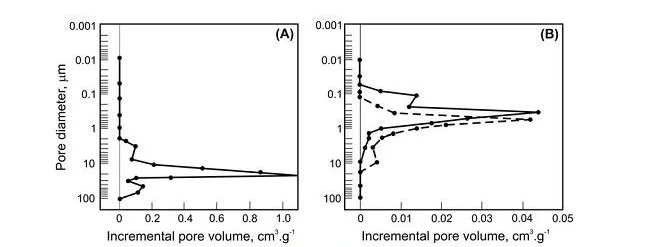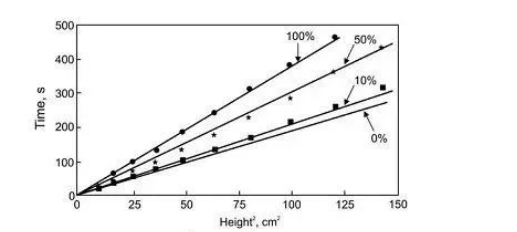The performance characteristics of VRLA batteries are largely determined by the capillary characteristics of the AGM separator, that is, the ability to keep the micropores in the thickness direction of the separator filled with electrolyte and prevent the electrolyte from drying out and causing delamination. These properties are influenced by the micropore structure, especially the micropore distribution of AGM separator. The structure of AGM partition is studied in detail. He performed core aspiration measurements on AGM partitions made of fine and coarse glass fibers. After the partition was cut into long strips, it was placed upright in H2SO4 solution with a relative density of 1.28. The lower part of the partition was immersed in the solution, and the time for the electrolyte core to reach different heights was measured. The core aspiration rates (height/core aspiration time) of AGM partitions containing 0%, 10%, 50% or 100% fine fibers are listed.

It can be observed from the figure that there is an obvious linear relationship between the two. Using the equation and further theoretical analysis, Laplace equation is obtained as follows:

Where p is the capillary pressure, r is the aperture, γ is the internal surface tension, and θ is the contact Angle. By changing the ratio between fine and coarse fibers, AGM partitions with a certain micropore size structure can be produced.
The figure shows the pore size distribution in radius for an AGM separator sample produced using a low pressure extrusion process.

As the figure shows, about 90% of the micropores are 10-24 μm in diameter. These are mainly Z-plane micropores. About 5% of the macropores are between 30 and 100μm in diameter. In the VRLA battery, the AGM diaphragm hole system is in close contact with the hole system of the two types of plates. The figure shows the distribution of micropore sizes of active substances on positive and negative plates. For the new, fully formed plates, 80% of the micropore diameter of the active material is less than 1μm. This value is significantly lower than the medium aperture of the AGM separator. When the polar group is under pressure, the AGM separator is pressed against the plate, thus ensuring a close contact between the two surfaces. After single cell vacuuming, the injected electrolyte is first absorbed by the plate micropores, and then by the diaphragm micropores. According to the technical requirements, the AGM separator should ensure that 96% of the micropores are filled with electrolyte.
When the plate begins to gas out, the electrolyte in the plate micropores is extruded and quickly adsorbed into the separator micropores, so that the separator is completely saturated. When the circuit is disconnected, the gas leaves the plate microhole, and the electrolyte inhaled by the separator is sucked back into the plate microhole. Thus, only the large diameter micropores in the AGM separator remain porous, while the plate micropores are in turn filled with electrolyte. Therefore, the parameter "electrolyte saturation" is mainly used for AGM partitions.
The porosity of a 225g/m2 AGM sample was shown to change with applied pressure (not exceeding 138kPa). The porosity is expressed as the ratio (percentage) between the micropore volume and the total volume of the AGM separator.

Under the above pressure, the porosity of AGM changes greatly. The wall thickness of the battery case should be large to resist this high pressure. Therefore, the pressure in the x-y plane of the separator has only a slight effect on the porosity
Why does pressure have such a small effect on the porosity of the diaphragm? The diaphragm glass fiber structure consists of randomly bonded fibers, but this is mainly in the x-y plane of the AGM, and the largest hole is in the Z-axis direction perpendicular to the x-y plane. The effect of partition compression on the size of the Z-axis hole is very weak. However, this is not the case for x - and y-oriented hole sizes. Under pressure, these holes change significantly. Thus, a 15% compression results in a 50% reduction in the micropore diameter.
The microporous structure determines the properties of the AGM separator, and the pores of the plate are smaller and easier to absorb the electrolyte. During charging and discharging, the electrolyte is dynamically distributed in the entire electrode group. The compact pole group makes the separator fit to the plate, ensuring ion transport and oxygen transport.
categories
recent posts
scan to wechat:everexceed
